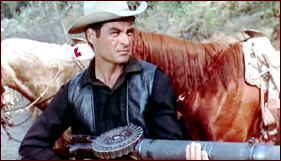Sun 14 May 2017
A Western Movie Review by Jonathan Lewis: THE TREASURE OF PANCHO VILLA (1955).
Posted by Steve under Reviews , Western movies[3] Comments
THE TREASURE OF PANCHO VILLA. RKO Radio Pictures, 1955. Rory Calhoun, Shelley Winters, Gilbert Roland, Joseph Calleia. Director: George Sherman.
When is a Spaghetti Western not a Spaghetti Western? When it’s a RKO color feature starring Rory Calhoun and Gilbert Roland. Filmed on location in Mexico, The Treasure of Pancho Villa is a structurally uneven, albeit thoroughly entertaining adventure film that predates not only the Italian Spaghetti Westerns of the 1960s, but also Sam Peckinpah’s The Wild Bunch (1969) and the ultra-violent Spaghetti and Paella (Spanish) Westerns of the 1970s. The common theme running through all of these genres and subgenres, at least when pertaining to stories set around the time of the Mexican Revolution, is the tension between idealists and mercenaries.

Such is the case in The Treasure of Pancho Villa. Calhoun portrays Tom Bryan, a somewhat unpleasant, rakish American mercenary working for revolutionaries in the Mexican Civil War. He’s a coldhearted sort, mainly interested in money. And he means business in more ways than one. He carries with him a Lewis machine gun that calls “La Cucaracha” and employs it numerous times throughout the story in order to mow down Mexican troops.
This violence – death at the hands of mechanized warfare – was a hallmark of many of the Mexican Revolution themed Euro-Westerns produced in the 1970s. In many ways, it represents Bryan’s personality perfectly. For him, killing Mexican troops is just a job and “La Cucaracha†is just useful tool at his disposal.
In direct contrast to Tom Bryan, Colonel Juan Castro (Gilbert Roland) is an idealist. He’s fighting for his ideals and believes strongly in Pancho Villa. He’s not on the take, can’t be bought or bribed, and is willing to use violence when necessary. He, however, seems not to get too much of a thrill out of it and certainly doesn’t strut around with a Lewis machine gun like his “ugly American†counterpart.
For a time, the two men find themselves on the same side, both fighting for Pancho Villa. Together, they rob a train carrying gold and begin the process of transporting the loot across rugged terrain in order to deliver it personally to Pancho Village. But when the Mexican revolutionary leader fails to show up, things fall apart between the two men, leading to a series of twists and turns that eventually has them joined together again against a common foe. As I mentioned, it’s a plot that would be followed time and again in Spaghetti Westerns that were set during the Mexican Revolution.
Spaghetti Westerns, for the most part, didn’t often have unnecessary romantic subplots that only served to distract from the action at hand. Unfortunately, that is not the case in The Treasure of Pancho Villa with the introduction of the character of Ruth Harris (Shelley Winters), an American schoolteacher living in Mexico who has fallen in love with the revolution’s ideals. Bryan’s romantic feelings for her never seem real, nor despite what he says at the end of the film, is it believable that Juan Castro could have seen himself with her.
That said, The Treasure of Pancho Villa was a surprisingly enjoyable action adventure film. Gilbert Roland was perfectly cast as Juan Castro and [spoiler alert], despite the fact that his character doesn’t end up surviving the onslaught of the Mexican Army, the story told in the movie is about his impact on Bryan’s worldview. For it’s only through his encounter with a man who believed in something more than money, in something greater than enriching himself, that Bryan learns what honor and loyalty are.
May 15th, 2017 at 3:30 pm
Always a pleasure watching Rory Calhoun and Gilbert Roland, but I thought it dragged a bit, mostly (as you noted) due to Shelley Winters’ character.
Sherman did another draggy Mexican Western about this time, LAST OF THE FAST GUNS, with Roland and Jock Mahoney.
May 15th, 2017 at 3:44 pm
I’ve not seen this one, but even before Dan left his comment, I was thinking that I just can’t see any romantic sparks flying between Shelley Winter and either Rory Calhoun or Gilbert Roland.
May 15th, 2017 at 9:12 pm
I like this one too, and often pair it with Bob Mitchum and Zachary Scott in BANDIDO.